The Samsung Galaxy S9 and S9+ Review: Exynos and Snapdragon at 960fps
by Andrei Frumusanu on March 26, 2018 10:00 AM ESTDisplay Evaluation & Power
The displays of the Galaxy S9’s don’t change much compared to the Galaxy S8’s. The S9 uses an upgraded AMOLED DDIC S6E3HA8 instead of last year’s S6E3HA6. The new panels are AMB577PX01 on the Galaxy S9 and an AMB622NP01 on the Galaxy S9+.
A nice addition with Samsung’s Android 8.0 OS on the Galaxy S8 and Galaxy S9 is the ability have fine-grained control over colour temperature – although it’s disappointing to see that this is limited to the Adaptive Display colour mode. The remaining colour modes continue Samsung’s tradition to provide different colour space modes. Adaptive Display is a wide gamut mode which is intentionally wide and doesn’t correspond to any standard. AMOLED Cinema targets the DCI P3 colour space, AMOLED Photo targets Adobe RGB and the simple “Basic” mode targets sRGB accuracy.
One big introduction of Android 8.0 was supposed to be the inclusion of wide colour gamut colour management support. This was enabled on Google’s Pixel 2 devices. To find out more how the Galaxy S9 behaves I wrote a quick app which check’s Android’s APIs. Unfortunately the Galaxy S9 doesn’t have any colour management support and switching colour modes through the APIs does nothing. There’s still a lot of questions remaining in terms of wide gamut support on Android, particularly for Samsung devices who make extensive usage of colour management and display modes through the mDNIe solutions on their AMOLED devices.
There’s a plethora of reasons of why Samsung could have decided not to enable support, some of them which are hardware requirements on the display pipeline. The Exynos 9810 and Snapdragon 845 both should support 10-bit display pipelines (which is not necessarily a requirement, but simplifies things) but for example the S6E3HA6 was still an 8-bit DDIC which complicates things and requires tone remapping and possibly dithering techniques. The situation is a bit of a conundrum and it’ll probably take some time before Samsung introduces a full 10-bit wide gamut software-to-display device. The Galaxy S9 for now remains the same as previous generation in terms of colour gamuts and colour depths.
And as always, measurements are performed with an X-Rite i1Pro 2 spectrophotometer, with the exception of black levels which are measured with an i1Display Pro colorimeter to achieve the most accurate results possible in an area where the i1Pro 2 can be somewhat unreliable. Data is collected and examined using SpectraCal's CalMAN software.
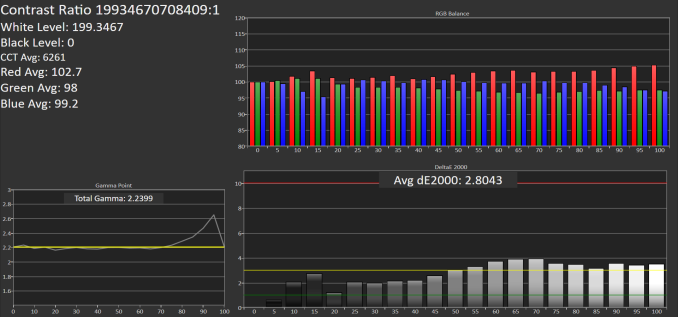
sRGB (Basic mode)
SpectraCal CalMAN
The Galaxy S9 and S9+ display generally the same characteristics as the Galaxy S8. Minimum brightness goes down to 1.5 cd/m² while manual maximum brightness tops out at 300-320 depending on colour mode. Auto-brightness boost in bright conditions will overdrive the panel at up to 625 cd/m² at 100 APL (full white) which is the same brightness as the S8, both in manual and auto modes.
The Galaxy S9 and S9+ units I have here still suffer from slightly too low colour temperatures both in sRGB and DCI P3 modes, coming in at around 6250K, slightly better than the Galaxy S8 unit I have which also was too red at 6150K. Samsung’s Adaptive Mode default to higher colour temperature of 7000K, however in that mode it’s a non-issue as you’re able to adjust the colour balance to one’s preference. The Galaxy S9 and S9+ showcase better total gamma than the S8 units I have here, coming in at 2.23 on the S9’s vs 2.13 on the S8.
Greyscale accuracy is good even though we’re veering slightly too much into the reds because of the under-targeted colour temperature.
In direct sunlight the S9’s retrain fantastic readability thanks to the high-brigthness mode that the phone switches to. In this mode the display ignores the selected display mode and goes into a special very saturated and very low gamma mode to improve legibility.
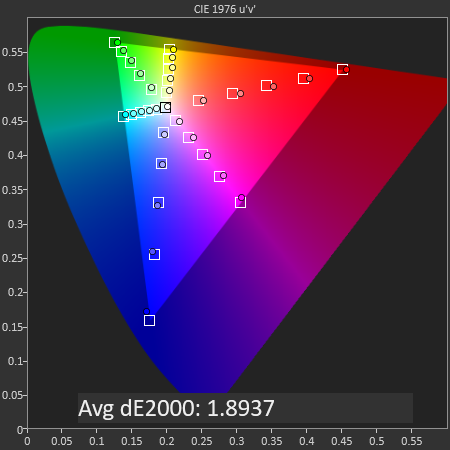
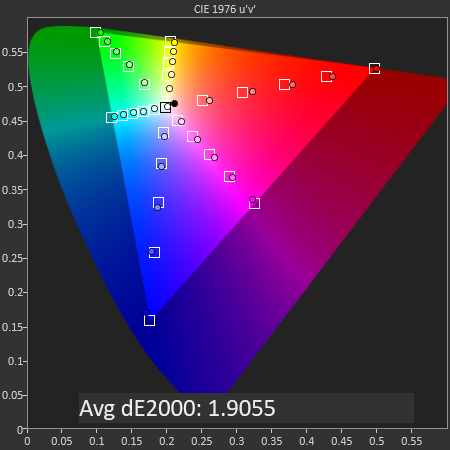
sRGB (Basic mode) & DCI P3 (AMOLED Cinema) Saturations
SpectraCal CalMAN
In terms of gamut and saturations accuracy the S9+ behaves excellently in sRGB and DCI P3 modes. However I did see that the mid-level red saturation points were too high and this prohibited the S9’s from reaching lower overall dE2000 figures. Because I measured the exact same deviation between the S9 and S9+ I believe this to be a calibration issue of the mDNIe profiles rather than an issue of the panels which Samsung could theoretically fix through software if they wanted to (along with the colour temperature being too red).
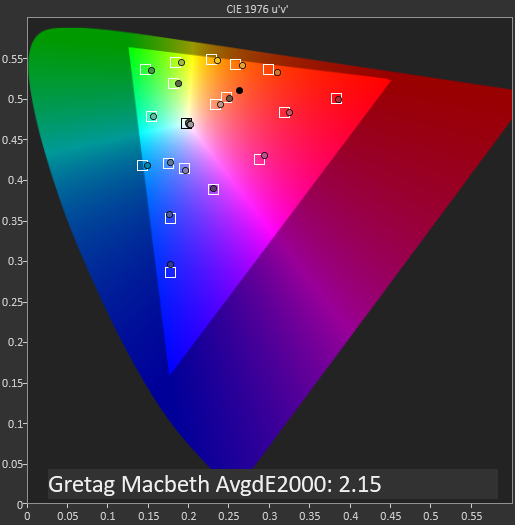
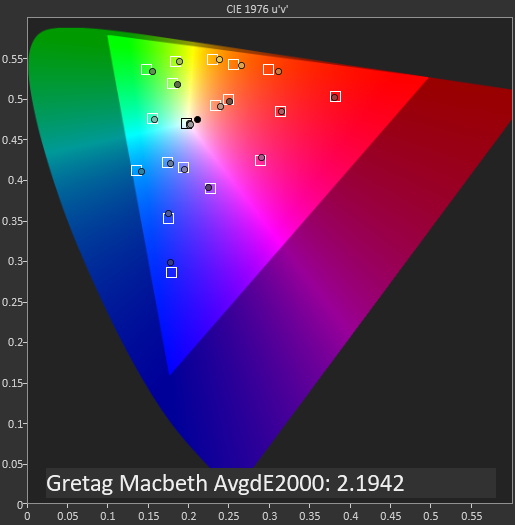
sRGB (Basic mode) & DCI P3 (AMOLED Cinema) GMB
SpectraCal CalMAN
In the GMB charts the Galaxy S9 and S9+ again posted identical figures with overall good accuracy in sRGB and DCI P3 modes. Again the biggest mis-alignments here happen in the red tones are they are too saturated than what they should have been.
Something we’ve never covered before is a certain behaviour of AMOLED screens at low brightness and dark contents. Samsung has for generations had issues with transitions from complete black (pixels off) and lowest level colours. Now with having more competition in the OLED scene both from LG in terms of panels and from Apple with the iPhone X, I found it interesting to compare how the different devices behave.
This sort of evaluation is extremely hard to capture as it can’t really be measured with tools into a quantized figure. I resorted to simply capturing the phone’s screens with a DSLR at long exposure times. Alongside the long-exposures which exaggerate the brightness of the scene compared to the reference image, I also included the same image captures but with the high-lighted shadow clipping showcasing the areas of complete black of the screens. The phones had all been calibrated to a fixed 20cd/m² brightness to have an apples-to-apples comparison.
The Galaxy S9 and S9+ both are darker and more even in brightness than the Galaxy S8. This matches our measurement which showed the S9’s have higher gamma than the S8 (for our units). The Galaxy S9’s provided a better representation of the source material than the S8. There is a difference between the S9 and S9+ as the S9+ seemed to have a higher gamma or more clipping between black and the darkest areas. The problem here is that this clipping gradient isn’t smooth enough and in motion this results in very noticeable moving artefacts.
The iPhone X behaved very differently than any Samsung devices and provided a significant image quality advantage in dark scenes. When looking at the shadow clipping highlighting that Apple is doing some very fine dithering between fully dark areas and the next highest brightness levels. When in motion the iPhone X just provides an extremely good experience in dark scenes with little to no visible artifacts.
The Pixel 2 XL comes with an LG panel and DDIC. The results here are a complete mess as not only does the Pixel 2 XL have issues with the dark areas, but actually the gamma curve at low levels is far too high and this clips actual detail of the image into complete black. The LG V30 has the same issues and I hear this is a hardware limitation on the way LG handles brightness control through PWM – it’s not able to retain sufficient ADC bit depth resolution at low brightness and causes a more compressed image.
Apple’s screen also doesn’t suffer from the “purple smudging” when transitioning between black areas. This seems to be caused by a lag in the response-time of the blue subpixels, not able to shut off quickly enough. The point here is that if Apple can handle dark scenes at low brightness levels at good quality, then so should Samsung, so here’s hoping Samsung’s engineers can focus on this issue and improve it in future generations.
| Screen Luminance Power Efficiency 100% APL / White |
||||||
| Device | Screen Luminance Power at 200cd/m² |
Luminance Power (mW) / Screen area (cm²) Efficiency |
||||
| Galaxy Note 5 | 504 mW | 5.64 | ||||
| Galaxy S6 | 442 mW | 5.99 | ||||
| Galaxy S9 | 563 mW | 6.69 | ||||
| Galaxy S8 | 590 mW | 7.01 | ||||
| Galaxy S5 | 532 mW | 7.21 | ||||
| Galaxy Note 4 | 665 mW | 7.22 | ||||
| Galaxy S5 LTEA | 605 mW | 8.20 | ||||
| Galaxy S4 | 653 mW | 9.22 | ||||
A big question I wanted to see an answer to is if the Galaxy S9 had improved in terms of power consumption and efficiency. As it stands, power on the S8 and S9 were nearly identical and the measured difference was within 5%. We haven’t seen an improvement in AMOLED emission power efficiency in a few generations now so I do wonder if my projection of AMOLEDs surpassing LCDs in overall efficiency from 3 years ago has actually happened or not. I didn’t have time to go in-depth in other current generation devices for this article, but I’ll make sure to give an update in a separate piece in the near future.
Overall the Galaxy S9 screens behave mostly the same as the ones on the Galaxy S8’s. The only differences between the screens that will be visible is the higher gamma at low brightness levels which slightly improve the quality. The Galaxy S9’s screens are still one of the best on the market and I don’t really see any deal-breaking issues with the phones in that regard.


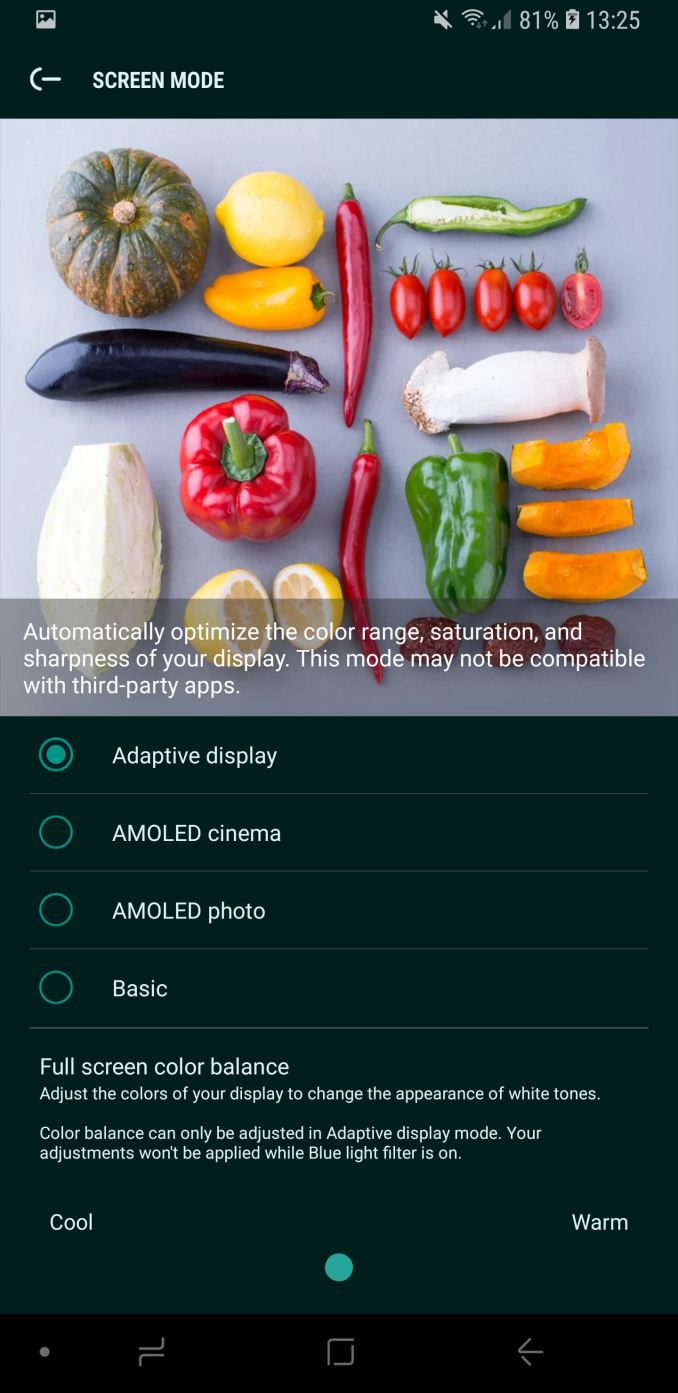
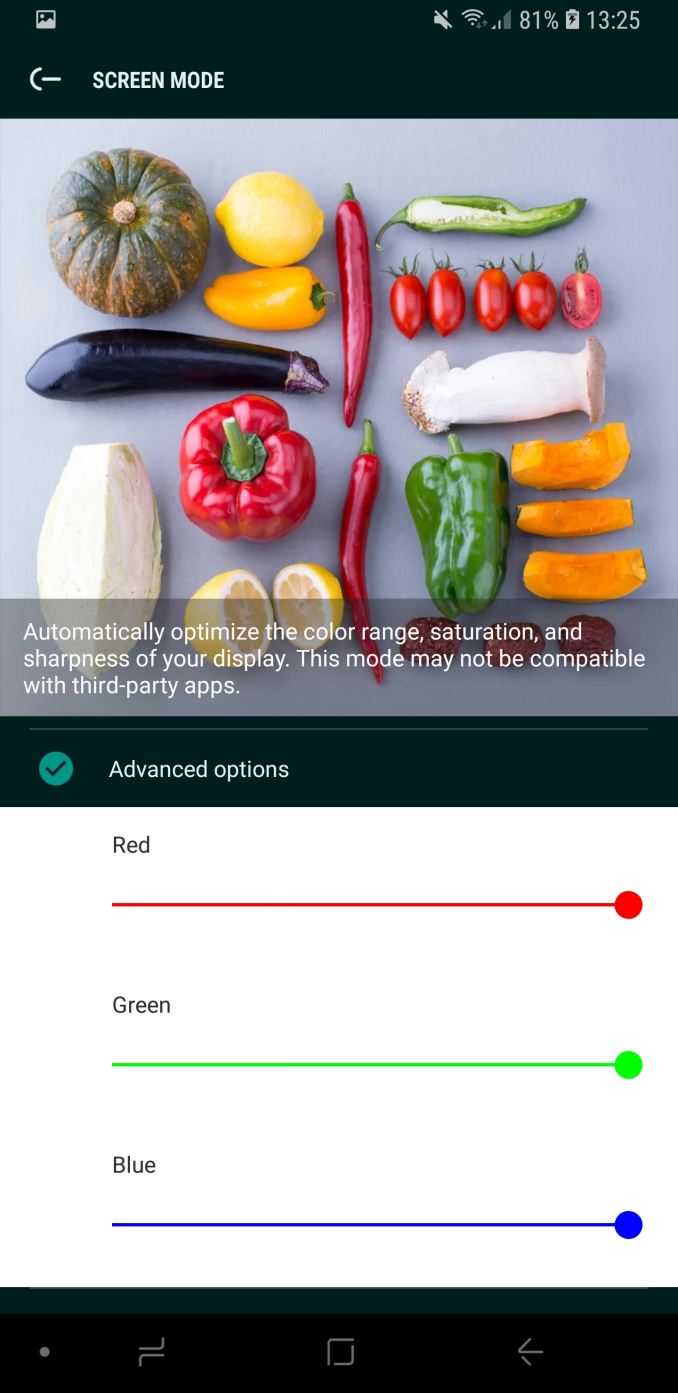














190 Comments
View All Comments
peevee - Friday, April 6, 2018 - link
Essential 2?Given small real-life difference between 845 and 835, Essential PH-1 is still a great device. And very appropriately priced. Nothing to wait there.
StrangerGuy - Tuesday, March 27, 2018 - link
All the S9 did was made me appreciate my S8+ more, of which I only bought because of generous employer benefits. Without which I wouldn't even have cared about these overpriced flagships.Valantar - Tuesday, March 27, 2018 - link
I pointed this out in your S9 launch article, and apparently I have to make my point again: neither light nor depth of field is the reason for the aperture change - it's purely to combat distortions and lack of sharpness in the image due to the combination of a large aperture and tiny, tiny glass.Why? When it comes to depth of field, one needs to factor in not only the aperture, but also the crop factor (sensor size relative to standard 35mm film). As such, f/1.5 on a standard cell phone 1/2.3" sensor is roughly equal to f/8.4 on a 35mm sensor, or f/5.6 on an APS-C sensor. This is one of the main photographic advantages of large-sensor cameras: that you can get shallow depth of field with lenses that are actually possible to manufacture.
An example: https://dofsimulator.net/en/?x=EAyAeuF3AAAIJEwkAAA...
As you can see here, with a 1/2.3" f/1.5 sensor, focusing on a subject 3m away gives you an in-focus area of ~43m - this is NOT too little, not by any measure. Moving the subject to 5m gives you effectively infinite focus, with everything from 1.9 to infinity being in the focal plane. You'd need your subject at less than .5 meters for DoF to be an issue - which it would be with most cameras at that distance.
On the other hand, it's well known that for large apertures, anything but the best glass will lead to aberrations and distortions in the image, and a general loss of sharpness across the frame. Look at even a single DSLR lens review - they're _always_ sharper when stopped down. With a lens stack this tiny, there's no feasible way to control this - it's likely physically impossible to avoid aberrations and distortions at an aperture number like this. Hence, the variable aperture.
Now, AT is usually very accurate in their reporting. Could you PLEASE correct this? Pretty please? Since you claim to be doing a deep-dive into the camera, this is not a good look.
Valantar - Tuesday, March 27, 2018 - link
To clarify: You say that "The F/2.4 aperture in day-light shots is not a gimmick and very much an advantage to the S9 as its deeper depth of field is noticeable in shots, producing sharper images than the F/1.5 aperture." This is a misunderstood conclusion. The added sharpness is largely not due to a deeper depth of field, but rather due to the stopped-down aperture resulting in a generally sharper image. This conflates two different characteristics, focus depth and lens/optical sharpness. These are not the same. If you did a more rigorous test where both cameras focused on the same spot (ideally not in the centre of the image) in a scene with sufficient depth, or conversely shot against a flat target with a lot of detail, you'd likely see this pretty clearly, as _even the focal point_ would be sharper at f/2.4. If this was due to depth of field, both settings would be equally sharp at the focus point, while what you're saying here is that f/2.4 is sharper _across the image_. That's a typical effect of a smaller aperture improving sharpness, not of the smaller aperture restricting DoF.peevee - Friday, April 6, 2018 - link
" _even the focal point_ would be sharper at f/2.4"If it is the center, it might not be so because with such tiny sensor, at f/2.4 maximum resolution is diffraction-limited. Need the exact size of the sensor to confirm, but I am almost sure than even at f/1.5 Airy disk is bigger than a pixel.
Takethis - Tuesday, March 27, 2018 - link
Any chance they Samsung could fix their “slow-and-steady” DVFS approach with software updates? Given the actual state of things, Snapdragon 845 phones are the one to buy this year (I'm thinking Oneplus 6)Ankurg - Tuesday, March 27, 2018 - link
With due respect to the author and the site, I have to believe that most of the extensive tests and their results will not affect the avg day-to-day usage of this device.I am already seeing the panic this review has created on reddit, with many people now re-thinking whether to purchase or not...
Yes, most youtube/site reviewers don't go as deep as this, but a problem so steep would have been felt.
I would advice my fellow mates here not to lose sight of the fact that this is the best android phone you can buy right now.....irrespective of the choice of chip.
SirCanealot - Tuesday, March 27, 2018 - link
"With due respect to the author and the site, I have to believe that most of the extensive tests and their results will not affect the avg day-to-day usage of this device."While I'm happy to have a super-fast phone with crappy battery life, I'm not happy to have an average-speed phone with crappy battery life. IE, I have a Exynos Note 4 which is fast with crappy battery life and it still does the job...
The crappy battery life is going to effect every single user and every one of your friends in America is going to get a better performing phone with better battery life. Day-to-day I'm getting worse performance and battery life; this means I can re-consider my options now I have all the data.
Why shouldn't this review make you reconsider? That's what it's meant to do. Unless you're a Samsung shareholder, I wouldn't pay any attention to this completely normal thing of human society...
id4andrei - Tuesday, March 27, 2018 - link
The author himself stated that you will not see any difference as an ordinary consumer. Some slight circumstantial scrolling stutters are all he noticed.Still the Exynos underperforms relative to its advances in chip design.
peevee - Friday, April 6, 2018 - link
"The author himself stated that you will not see any difference as an ordinary consumer."Nope. The fast core only winding up after 0.4s is VERY noticeable as good phones will already finish launching an app or rendering a local HTML in Webview by this time, some time ago.